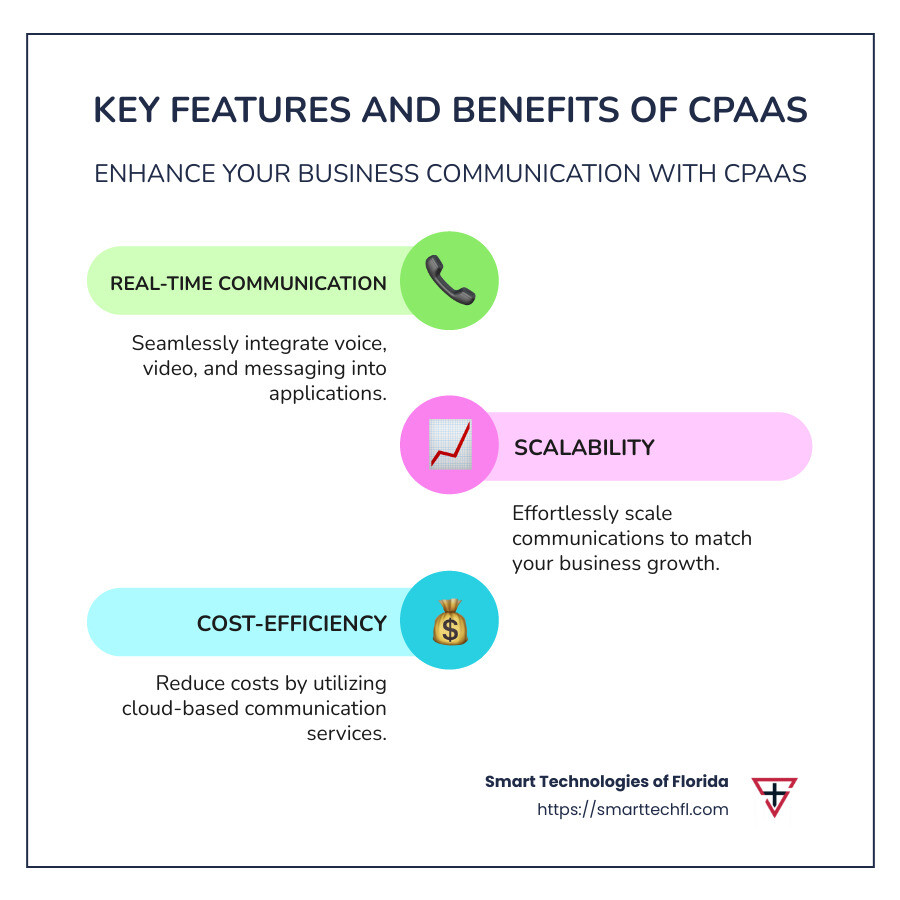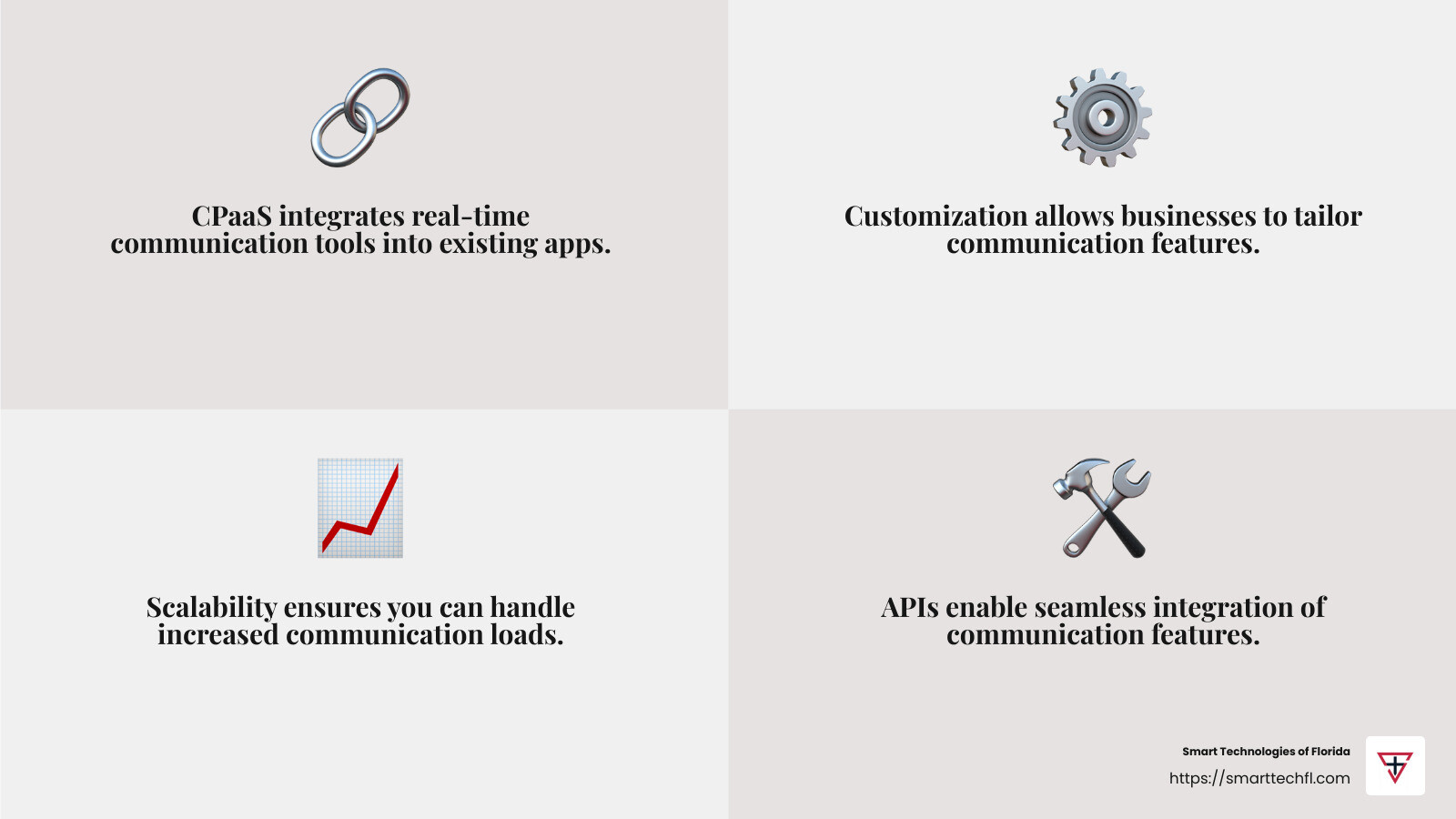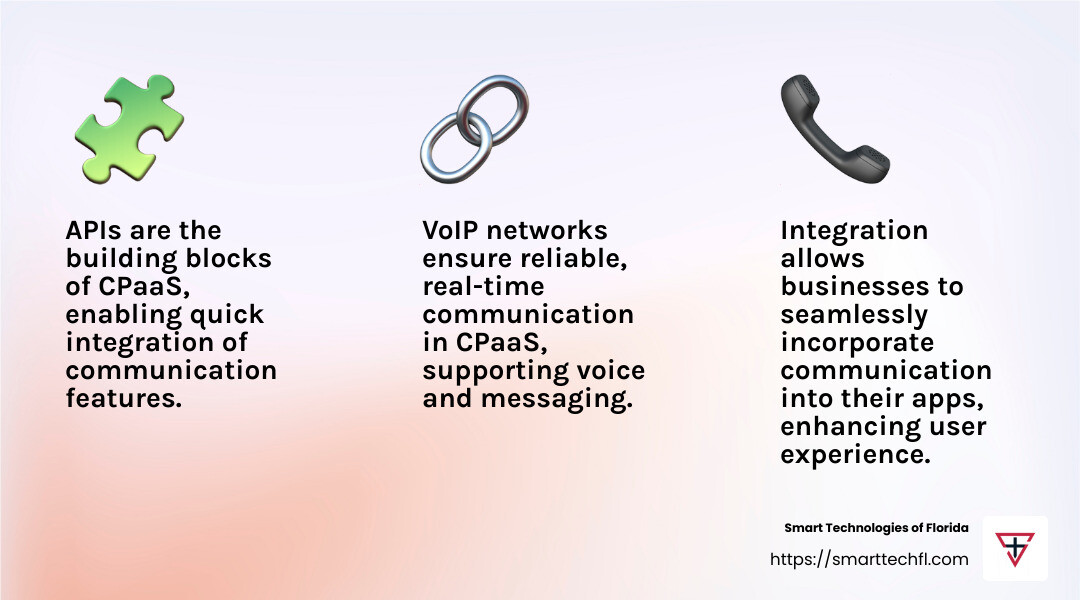The ABCs of CPaaS: Understanding Cloud Communication Services
Communications platforms as a service (CPaaS) are changing the way businesses interact with customers. These cloud-based platforms allow organizations to integrate real-time communication features, like voice, video, and messaging, directly into their existing business applications. This provides a seamless experience for users and can improve both operational efficiency and customer engagement. If you’re curious about the benefits of adopting this technology, here’s a quick overview:
- Definition: CPaaS provides cloud-based tools to add real-time communications — like voice, messaging, and video — to existing applications.
- Main Features: Includes APIs, which are essential for integrating communication features into apps without extensive back-end infrastructure.
- Usage: Perfect for businesses wanting to improve customer service, such as adding in-app messaging or video calls.
For businesses, especially those like mid-sized retail companies, staying up to date with modern communication technology is key to reducing costs and improving customer interactions.

What is Communications Platform as a Service?
Imagine being able to add phone calls, video chats, or text messages to your app without building everything from scratch. That’s what Communications Platform as a Service (CPaaS) offers. It’s a cloud delivery model that allows businesses to incorporate real-time communication features into their apps using APIs.
Cloud Delivery Model
CPaaS operates in the cloud, which means you don’t need to worry about maintaining or upgrading hardware. Everything runs on the internet, making it easy to scale up or down based on your needs. This flexibility is a game-changer for businesses that experience seasonal spikes in communication, like retail companies during holiday sales.
APIs: The Building Blocks
APIs, or Application Program Interfaces, are like the building blocks of CPaaS. They allow developers to integrate various communication features, such as voice, video, and messaging, into existing applications. With these tools, you can add a chat feature to your app or enable video calls without starting from zero.
Voice and Messaging
Voice and messaging are core elements of CPaaS. These features can be embedded into business applications to improve customer interactions. For example, a customer service app can have a “click-to-call” button, enabling users to connect with support instantly. Messaging APIs can send SMS notifications or reminders to users, keeping them engaged and informed.
By leveraging CPaaS, businesses can provide a seamless communication experience, ensuring users can interact with their services in real-time. This integration not only improves user satisfaction but also boosts operational efficiency.
Key Features of CPaaS
Real-Time Communication
One of the standout features of communications platforms as a service is the ability to offer real-time communication. Imagine a healthcare app where doctors can consult with patients via video call instantly. Or a retail app where customer support can resolve issues through live chat. CPaaS makes this possible by integrating these dynamic communication tools into existing apps, enhancing user interaction and satisfaction.
Customization
CPaaS offers remarkable customization capabilities. Unlike traditional communication systems that offer a one-size-fits-all approach, CPaaS lets businesses tailor communication features to their specific needs. Whether you want to add SMS alerts for appointment reminders or integrate voice calls for customer support, CPaaS provides the flexibility to choose exactly what you need. This level of customization ensures that businesses can create unique communication experiences that align with their brand and customer expectations.
Scalability
Scalability is another key feature that sets CPaaS apart. As your business grows, your communication needs may change. With CPaaS, you can easily scale your communication features up or down without significant investment in infrastructure. This adaptability is crucial for businesses that experience fluctuating demand, such as e-commerce platforms during holiday seasons. By using a cloud-based model, CPaaS ensures that you can handle increased communication loads seamlessly.
APIs: The Backbone of Integration
APIs are the backbone of CPaaS, enabling seamless integration of communication features into existing applications. These APIs are standards-based, making them reliable and easy to use. They allow developers to add functionalities like voice, video, SMS, and more without building them from scratch. This not only speeds up the development process but also reduces costs, allowing businesses to focus on innovation and customer satisfaction.
By using these key features, businesses can transform their communication strategies, offering real-time, customized, and scalable solutions that meet the demands of today’s digital world.

How CPaaS Works
Communications platforms as a service (CPaaS) are powered by communication APIs. These APIs enable developers to add real-time communication capabilities like voice, video, and messaging to existing apps. Think of APIs as the glue that connects different software components, allowing them to work together seamlessly.
Communication APIs: The Building Blocks
APIs are like the building blocks of CPaaS. They let developers add features like SMS notifications or video calls without starting from scratch. APIs are standards-based, meaning they’re designed to be reliable and easy to use. This makes it simpler for developers to integrate new features quickly and efficiently.
Integration: Bringing It All Together
Integration is where the magic happens. With CPaaS, businesses can integrate communication features into their apps, creating a seamless user experience. For example, a ride-sharing app might use CPaaS to send SMS alerts about ride status or to enable drivers and riders to communicate directly through the app. This integration improves functionality and user satisfaction.
VoIP Networks: The Backbone of Communication
Voice over IP (VoIP) networks are crucial for CPaaS. They handle the data packets that make real-time communication possible. When you make a call or send a message through an app, VoIP networks ensure that data travels quickly and reliably between endpoints. This allows for clear and uninterrupted communication, no matter where you are.

Real-World Example: Ride-Sharing Apps
Imagine using a ride-sharing app. When you book a ride, the app sends you a confirmation via SMS, lets you call the driver through the app, and provides real-time updates on the driver’s location. All these features are made possible by CPaaS, which integrates these communication tools into the app seamlessly.
By leveraging communication APIs, integration, and VoIP networks, CPaaS empowers businesses to improve their apps with powerful communication capabilities. This not only improves user experience but also streamlines operations and drives innovation.
Benefits of CPaaS
Flexibility is a cornerstone of communications platforms as a service. With CPaaS, businesses can pick and choose the communication features they need, like SMS, video calls, or chatbots, and integrate them into their existing systems. This means companies can tailor their communication tools to fit their specific needs without being locked into a one-size-fits-all solution.
Cost-efficiency is another major advantage. Traditional communication systems often require significant investments in hardware and maintenance. CPaaS, on the other hand, operates on a pay-as-you-go model. This allows businesses to pay only for what they use, making it a more economical choice. For instance, businesses don’t have to invest in expensive infrastructure upfront, which can lead to substantial savings.
Innovation thrives in the CPaaS environment. By using pre-built APIs, companies can quickly add new communication features to their apps, fostering innovation. This rapid integration allows businesses to stay ahead of the competition by offering the latest features and services to their customers. For example, integrating a video-enabled help desk into an app can transform customer service by providing immediate, face-to-face support.
Scalability is seamlessly built into CPaaS. As a business grows, its communication needs can change. CPaaS allows for easy scaling of communication tools to match demand. Whether it’s handling a surge in customer service inquiries or expanding to new markets, CPaaS can scale up or down effortlessly. This ensures that businesses can adapt to changing needs without any disruption.
By offering flexibility, cost-efficiency, innovation, and scalability, CPaaS provides businesses with the tools they need to improve their communication capabilities and drive growth. This makes it an attractive option for companies looking to streamline their operations and improve customer interactions.
CPaaS vs. UCaaS
When it comes to modernizing communication systems, businesses often find themselves choosing between Communications Platforms as a Service (CPaaS) and Unified Communications as a Service (UCaaS). Both offer unique benefits, but they cater to different needs.
Customization is where CPaaS shines. It offers businesses the flexibility to integrate specific communication features like voice, video, or chat into their existing systems using APIs. This means companies can tailor their communication stack to meet precise needs. Imagine having a blank canvas where you can paint exactly what you need—CPaaS allows for just that.
In contrast, UCaaS provides a ready-made solution. It’s like buying a complete painting. You get an all-in-one platform with built-in features such as phone services, video conferencing, and messaging. While this limits customization, it simplifies deployment, making it ideal for businesses seeking an out-of-the-box communication solution.
Development effort varies significantly between the two. CPaaS requires more technical expertise since businesses need to integrate APIs into their systems. This might not be suitable for companies with limited technical resources. On the other hand, UCaaS is simpler, offering a plug-and-play experience with minimal setup required.
Scalability is a strong point for both CPaaS and UCaaS. CPaaS allows businesses to scale their communication tools up or down based on demand, ensuring efficient resource use. UCaaS also offers scalability, but within the confines of its built-in features. Both solutions can grow with a business, but CPaaS offers more flexibility in scaling specific features.
When considering your communication stack, think about your business needs. If you need a highly customizable solution that can integrate seamlessly with existing systems, CPaaS is the way to go. However, if you’re looking for a comprehensive, easy-to-deploy platform with a broad range of communication tools, UCaaS might be the better choice.
Frequently Asked Questions about Communications Platforms as a Service
What is an example of a CPaaS?
Imagine getting instant updates about your package delivery through a text message or confirming a doctor’s appointment via a quick chat. Communications Platforms as a Service (CPaaS) make these real-time interactions possible. CPaaS provides tools like SMS (Short Message Service) and MMS (Multimedia Messaging Service) to send text and picture messages directly from your apps.
Another powerful feature of CPaaS is chatbots. These automated helpers can answer customer questions, schedule appointments, and even make recommendations, all through a chat interface. With CPaaS, businesses can integrate these features into their existing systems easily, without needing to build complex communication tools from scratch.
What should you look for in a CPaaS provider?
When selecting a CPaaS provider, it’s important to consider factors like reliability, innovation, and the range of communication tools offered. Look for providers that offer robust API offerings enabling voice, messaging, and video capabilities. It’s also beneficial to choose a provider that caters to businesses of all sizes and provides best-of-breed solutions for messaging, voice, email, and video. A strong reputation for helping businesses create seamless, scalable communication solutions is a key indicator of a reliable provider.
What are the problems with CPaaS?
While CPaaS offers many benefits, it’s not without its challenges. One major concern is security vulnerabilities. If platforms are not properly encrypted, sensitive data can be exposed to unauthorized users. This makes it crucial for businesses to choose providers that prioritize data security and offer robust protection measures.
Integration challenges are another issue. Companies often face difficulties when trying to incorporate CPaaS features into their existing systems, especially if those systems are outdated or incompatible. This can lead to a reliance on multiple vendors to cover all communication needs, complicating management and increasing costs.
By understanding these potential problems, businesses can make informed decisions when selecting a CPaaS provider, ensuring they choose a partner that offers secure, seamless integration capabilities.
Conclusion
At Smart Technologies of Florida, we understand that navigating the digital landscape can be complex. That’s why we focus on providing custom digital solutions custom to your unique business needs. Our expertise in communications platforms as a service (CPaaS) allows us to help you integrate real-time communication features seamlessly into your existing systems.
Our approach is people-centric, ensuring that every solution is aligned with your strategic goals. We believe in empowering businesses through strategic change and innovation. With 23 years of experience, we’ve seen how the right communication tools can transform customer interactions and drive business success.
By partnering with us, you’re choosing a team that’s dedicated to helping you steer the challenges of the digital age. Whether you’re looking to improve customer engagement or streamline operations, our custom solutions are designed to propel your business forward.
Explore how our VoIP phone systems can improve your communication capabilities and support your journey toward digital change. Let’s create a communication strategy that not only meets your current needs but also scales with your future growth.












